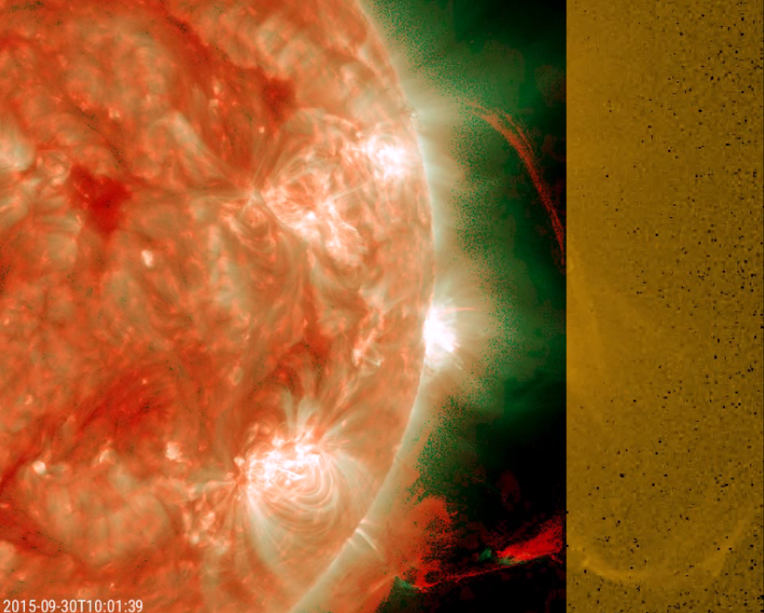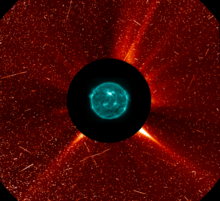news
Submitted on 2015-10-06
On 30 September, a prominence near the southwest solar limb got ejected into space. Prominences are clouds of plasma (charged particles) which are suspended in the corona, squeezed between large magnetic fields of opposite polarity, but denser and cooler than the surrounding coronal plasma. The structure had been visible during the last 2 weeks, before the surrounding magnetic field became unstable and ejected it into space starting around 07:30UT.

Submitted on 2015-09-30Rise and shine: That's exactly what active region NOAA 2422 did last week. From nothing, it started to emerge on 22 September as a simple bipolar sunspot region. Over the next few days, it developed into a fully mature sunspot group, gradually increasing its magnetic complexity. Until the 26th, it produced only a handful of C-class flares. However, by then, it had developed significant delta structures, i.e. spots of opposite magnetic polarity within the same penumbra, in its middle portion.
Submitted on 2015-09-23NOAA 2415 started out as a rather quiet and dull sunspot group, until during the afternoon of 14 September a bipolar magnetic flux emerged right in front (to the southwest) of NOAA 2415's main leading spot. During the next few hours and days, the newly bipolar region developed further, with the positive (white) polarity spots drifting away to the west. However, its negative (black) trailing spots remained very close to the original main spot (white), and started to interact with each other.
Submitted on 2015-09-16
This item was written by Matthew West and the PROBA2-team, and can also be read at their P2SC webpage.
Submitted on 2015-09-02NOAA 2403, an active region visible during the last 2 weeks of August, has been one of the largest and most complex sunspot groups so far this year. Its maximum surface area was 7 times that of the Earth, and its mixed magnetic polarities were the source of numerous small and moderate solar flares. No wonder that many astronomers took the time for a photoshoot of this marvellous sunspot group!

Submitted on 2015-08-05Solar activity has been very low over the last few weeks, with the last big solar flare already dating back to 25 June. That day, NOAA 2371 produced the last and strongest of its series of 6 M-class flares. The M7.9 flare peaked at 08:16UT and its space weather effects were extensively discussed in the 3 July 2015 Newsletter.

Submitted on 2015-07-29As discussed in a previous news item (see 4 June 2014), both STEREO spacecraft are on the other side of the Sun as seen from Earth. This is called a superior solar conjunction - see diagram underneath for the position of both spacecraft. For some time, each spacecraft is blocked by the solar disk making it impossible to communicate with it or receive data or images from it.
Submitted on 2015-07-23A very nice filament eruption occurred during the morning hours of 19 July. It was associated with a long-duration C2.1 flare that started at 09:22UT, peaked at 10:40UT, and ended at 13:02UT though it would take another 6 to 8 hours before the x-ray flux was back at its pre-event levels. The eruption of the filament itself took place between 07:00 and 10:00UT.


Submitted on 2015-07-16On 22 June 2015, the strongest proton event so far this year took place, with the greater than 10 MeV proton flux reaching 1070 pfu (proton flux units; Notes 1 and 2). It was only the 5th such event (more than 1000 pfu) so far this solar cycle (SC), and only the 41st since the start of systematic satellite measurements began in 1976. Interestingly, the maximum (19:00UT) coincided with a period of severe geomagnetic storming (Kp=8) from 18:00-21:00UT, and with a a moderate M6.5 flare peaking at 18:23UT. This was nicely illustrated by the overview chart from SWPC (image underneath).
Pages
Zircon - This is a contributing Drupal Theme
Design by
WeebPal.




















